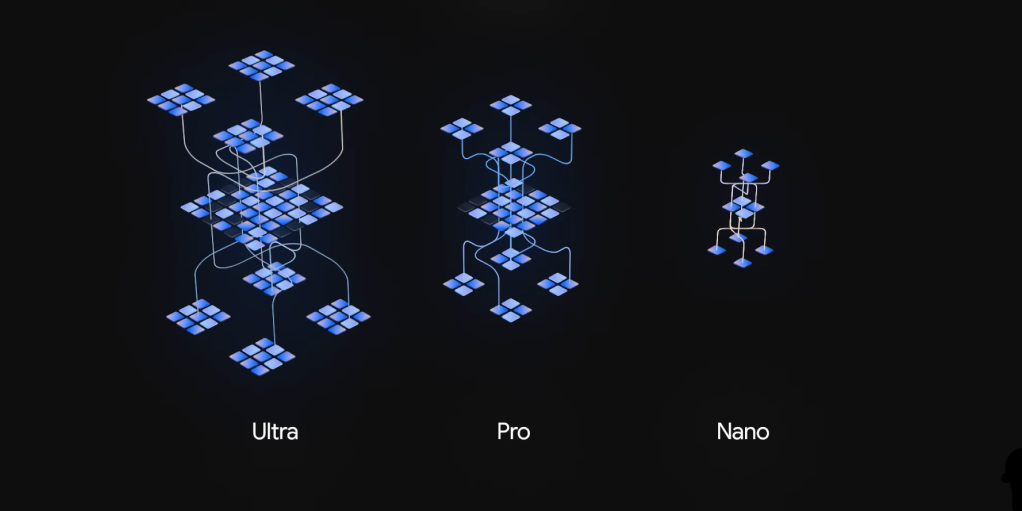The world of artificial intelligence just witnessed a giant leap forward with the launch of Google’s Gemini, a powerful and versatile AI model exceeding human performance on various benchmarks. This groundbreaking technology promises to revolutionize numerous industries and redefine our expectations of what AI can achieve.
What makes Gemini different?
Unlike other AI models, Gemini boasts several unique features:
-
Massive Multitask Language Understanding (MMLU):
Gemini is the first model to surpass human performance on MMLU, a complex test encompassing 57 subjects like math, physics, law, and medicine. This demonstrates its exceptional breadth and depth of knowledge.
-
Modular Architecture: Gemini comes in three variations:
Nano, Pro, and Ultra. Each variant is optimized for specific tasks and resource requirements, offering scalability and flexibility for diverse applications.
-
Custom Tensor Processing Units (TPUs):
Google’s latest TPUs power Gemini, significantly boosting its training efficiency and performance.
-
Extensive Capabilities:
From generating creative text formats to understanding and explaining complex code, Gemini’s capabilities are far-reaching and continuously evolving.
How does Gemini work?
Gemini leverages a cutting-edge architecture that combines various AI techniques, including:
-
Transformer-based Neural Networks:
Imagine a multi-lane highway where information flows freely between different points. This is essentially how transformer-based neural networks, the backbone of Gemini, operate. Instead of processing information sequentially, like traditional models, transformers use a parallel architecture, allowing them to analyze complex relationships within data much faster and more efficiently.
Think of it like analyzing a sentence. A traditional model would read each word one by one, losing sight of the context. A transformer, however, can analyze all the words simultaneously, understanding their individual meanings and how they interact with each other to form the overall message. This enables Gemini to grasp intricate nuances in language, code, and other complex information formats.
-
Multi-Task Learning:
Imagine a child learning to read, write, and calculate simultaneously. This is similar to multi-task learning, where a single AI model is trained on various tasks, allowing it to acquire generalizable knowledge and apply it across different domains.
Just like a child becomes more adept at all their subjects by learning them together, Gemini benefits from multi-task learning. By training on diverse tasks, such as text summarization, code writing, and image generation, Gemini develops a deeper understanding of the underlying principles that govern these tasks. This allows it to transfer this knowledge to new scenarios, making it more adaptable and versatile.
-
Self-Supervised Learning:
Imagine a student learning a new language by immersing themselves in the culture and environment. This is the essence of self-supervised learning, where AI models learn from unlabeled data.
Instead of relying on explicitly labeled data, Gemini can “learn by doing.” By analyzing vast amounts of unlabeled text, code, and images, it can discover patterns and relationships that enable it to perform various tasks without explicit instructions. This makes Gemini more efficient, as it can learn from readily available data without the need for extensive manual labeling, and more adaptable, as it can continuously improve its understanding by exploring new information.
These three innovative techniques combine to create the powerful and versatile architecture that drives Gemini. By harnessing the strengths of each, Gemini can process and understand complex information, adapt to new scenarios, and continuously improve its capabilities, paving the way for a future where AI plays a transformative role in diverse aspects of our lives.
The Gemini Model Family:
| Version | Ideal Use Cases | Features |
|---|---|---|
| Gemini Nano | On-Device Applications | Text Summarization, Smart Replies, Offline Processing |
| Gemini Pro | Cloud-based Deployment | Research, Content Creation, Code Generation, Large Language Models |
| Gemini Ultra | Large-Scale & Demanding Applications | Scientific Discovery, Complex Problem Solving, High-Performance Computing |
The Future with Gemini:
The launch of Gemini marks a turning point in AI development. Its immense capabilities and versatility promise to revolutionize various fields, from scientific research and healthcare to education and creative industries. As developers and researchers continue to explore Gemini’s potential, we can expect a future where AI seamlessly integrates with our lives, enhancing our capabilities and solving some of the world’s most pressing challenges.
Let’s Build Digital Excellence Together











